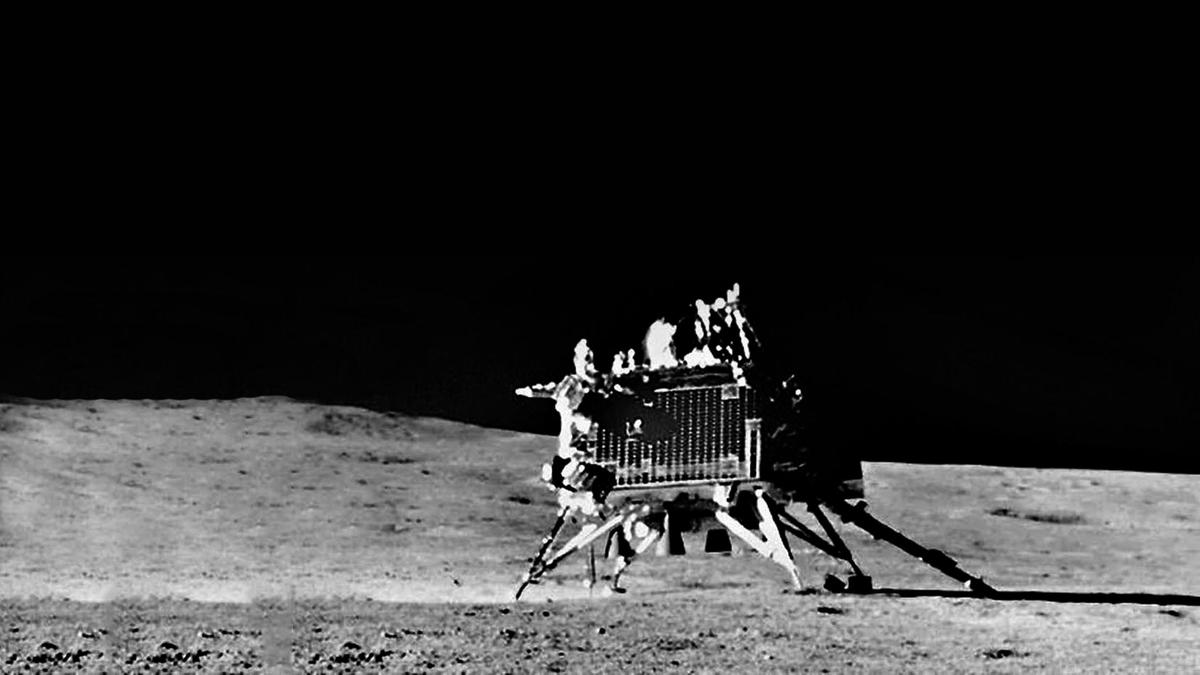Table of Contents
Chandrayaan-3’s Vikram Lander Generates “Ejecta Halo” on Lunar Surface

Vikram Lander of Chandrayaan-3 can be seen resting on the surface of the moon in this image clicked with Pragyan Rover’s navigation camera. | Photo Credit: ISRO
Significance of Vikram Lander’s “Ejecta Halo”
Chandrayaan-3’s lander module, Vikram, made a historic touchdown on the south pole of the moon on August 23, generating an intriguing phenomenon called the “ejecta halo.” This phenomenon has been the subject of a new study published in the Journal of the Indian Society of Remote Sensing on October 26. The findings shed light on the effects and characteristics of Vikram’s landing on the lunar surface.
Features and Objectives
The study titled “Characterisation of Ejecta Halo on the Lunar Surface Around Chandrayaan-3 Vikram Lander Using OHRC Imagery” analyzed high-resolution imagery from the Orbiter High-Resolution Camera (OHRC) of the Chandrayaan-2 orbiter. The research team aimed to explore the phenomenon of the “ejecta halo” and understand its extent and composition. By comparing pre- and post-landing imagery, they identified a bright patch surrounding the lander, known as the “ejecta halo,” which was caused by lunar dust being raised and displaced during the landing sequence.
Effects of the “Ejecta Halo”
The study estimated that the landing of Vikram Lander resulted in the ejection and displacement of approximately 2.06 tonnes of lunar epi regolith (a type of lunar surface material) over an area of 108.4 m² around the landing site. This finding provides valuable insight into the geological impact of lunar landings and helps expand our knowledge of lunar surface dynamics.
Pros and Cons
The discovery of the “ejecta halo” demonstrates the success of the Chandrayaan-3 mission and highlights India’s achievement as the fourth country to successfully land a spacecraft on the moon. By studying the effects of lunar landings, scientists can gain a better understanding of the moon’s composition and how it has evolved over time. However, the displacement of lunar regolith may also have unintended consequences, such as potentially obscuring or disturbing the surrounding lunar environment. Further research is needed to fully assess any negative impacts and mitigate them in future lunar missions.
Fun Fact
Did you know that Vikram Lander and its companion, the Pragyan Rover, successfully carried out an experiment where the lander hopped about 40 cm and landed safely at a short distance? This hop experiment was a significant milestone in the mission’s development and demonstrated the capabilities of the lunar lander.
Mutiple Choice Questions
1. What is the name of the lander module of Chandrayaan-3 that generated an ‘ejecta halo’ on the lunar surface?
a) Vikram
b) Pragyan Rover
c) Chandrayaan-3
d) ISRO
Explanation: The lander module of Chandrayaan-3 that generated an ‘ejecta halo’ on the lunar surface is called Vikram.
2. When did the historic touchdown of Vikram lander module occur on the south pole of the moon?
a) August 23
b) October 26
c) August 23, 2023
d) August 29
Explanation: The historic touchdown of the Vikram lander module on the south pole of the moon occurred on August 23.
3. What did Vikram lander module generate around itself when it landed on the moon?
a) Dust storm
b) Bright patch
c) Ejecta halo
d) Lunar regolith
Explanation: When Vikram lander module landed on the moon, it generated a bright patch around itself.
4. Where were the findings regarding the ‘ejecta halo’ of Vikram lander module published?
a) Journal of Lunar Science
b) Journal of Astrophysics
c) Journal of the Indian Society of Remote Sensing
d) Journal of Space Exploration
Explanation: The findings regarding the ‘ejecta halo’ of Vikram lander module were published in the Journal of the Indian Society of Remote Sensing.
5. How much lunar epi regolith material was estimated to be ejected and displaced by Vikram lander module?
a) 1.06 tonnes
b) 2.06 tonnes
c) 3.06 tonnes
d) 4.06 tonnes
Explanation: The estimation suggests that approximately 2.06 tonnes of lunar epi regolith material were ejected and displaced by Vikram lander module.
Brief Summary | UPSC – IAS
Chandrayaan-3’s lander module, Vikram, created an ‘ejecta halo’ on the surface of the moon during its landing on August 23. A study published in the Journal of the Indian Society of Remote Sensing revealed that Vikram raised lunar dust and generated a bright patch around itself upon touchdown. The study estimated that approximately 2.06 tonnes of lunar epi regolith were ejected and displaced over an area of 108.4 m² around the landing site. These findings provide further insight into the landing sequence and the behavior of lunar regolith. Efforts to revive Vikram and the rover after a lunar day have been unsuccessful.

